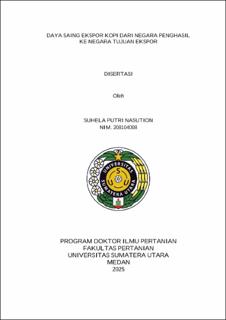Daya Saing Ekspor Kopi dari Negara Penghasil Ke Negara Tujuan Ekspor
Competitiveness of Coffee Exports from Producing Countries to Export Destination Countries

Date
2025Author
Nasution, Suhela Putri
Advisor(s)
Supriana, Tavi
Iskandarini
Wibowo, Rulianda Purnomo
Metadata
Show full item recordAbstract
Coffee is a leading commodity with an export value of USD 1.14 billion with an
export volume of 433,780 tons in 2022. The highest destination for Indonesian coffee
exports is the United States with a value of USD 268.55 million, followed by Japan with a
value of USD 59.09 million. The United States and Japan are the largest coffee importing
countries in the world. Research objectives: 1) To identify the competitiveness of
Indonesian coffee in the global market, 2) To identify what factors influence the volume of
Indonesian coffee exports in export destination countries, 3) To identify demand and
competition for Indonesian coffee in the global market. The analytical model used in this
research is Dynamic Revealed Comparative Advantage (DRCA) to see the dynamics of
Indonesian coffee export performance in the global market, then the Gravity Model to see
what factors influence the volume of Indonesian coffee exports in export destination
countries and the Gravity Model and Model Almost Ideal Demand System (AIDS) to see
the elasticity of demand and competition for Indonesian coffee in the global market. The
data used is secondary data in the form of the period 2003-2022. The results of the DRCA
research method show that the four coffee exporting countries have dynamic export
competition performance that tends to decline. Indonesia's coffee export performance for
the five periods 2003-2022 was in the positions of Leading retreat, Langging retreat, Lost
Opportunity, Rising star and Falling Star. These results indicate a decline in the share of
coffee exports and the share of total exports of Indonesian products in the international
market. Based on the results of the common effect model estimation, Indonesia's Gross
Domestic Product per capita (GDPI) and the exchange rate have a negative but significant
effect on Indonesian coffee exports. Meanwhile, the variables Gross Domestic Product per
capita importers (GDPIM) and trade costs have a positive and significant influence on the
volume of Indonesian coffee exports. However, the International Coffee Agreement (ICA)
has a positive but not significant effect on Indonesian coffee exports. The results of the
Almost Ideal Demand System (AIDS) analysis show that Indonesian coffee in the United
States and Japan markets is in fourth position after Brazil, Colombia and Vietnam. The
price elasticity of Indonesian, Brazilian and Vietnamese coffee is inelastic, while
Colombia's is elastic. Meanwhile, in the Japanese market, the price elasticity of Brazilian
and Colombian coffee is inelastic, while that of Vietnam and Indonesia is elastic. Then the
cross price elasticity of Indonesia and Brazil is positive and there is a substitution
relationship. Meanwhile, the cross price elasticity of Indonesia and Vietnam shows a
complementary relationship. For the Japanese market, the cross price elasticity between
Indonesia and Brazil is positive and shows a substitution relationship and is inelastic.
Meanwhile, Indonesia and Vietnam have negative values indicating a complementary
relationship and are elastic. The expenditure elasticity of Indonesian coffee exports in the
United States market is 0.644, indicating that Indonesian coffee is a normal good and is
inelastic. Meanwhile, the elasticity of expenditure on Indonesian coffee exports in the
Japanese market is 1.018, indicating that Indonesian coffee is a superior product and is
elastic.
